
Hawker Hover Rover 500
Light Hover Utility Vehicle
By D Hebditch
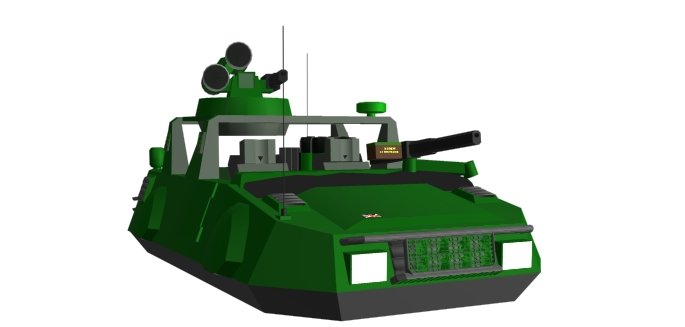
|
Introduction The Hover Rover is the ubiquitous light ACV vehicle in use with front-line British Army units. It has also been widely exported in military and civilian versions to a large number of clients. The Hover Rover is a robust and powerful vehicle used in a variety of roles: liaison and command, communications, light logistics and a highly mobile weapons platform to name but a few. It is the equivalent of the French AGL-12 or the Warbird in American service. Acknowledgements The HR500Q was developed from a concept by Abraham Gubler. Thanks to Bryn Monnery for stats and to David Gillon and Peter Grining for ideas on further variants of the Hover Rover. Narrative We put a lot of preparation time into our Hover Rovers prior to deploying from Adlerhorst. We'd managed to obtain, by the foulest means, the latest HR500 WMR+ special forces model, and they were an excellent piece of kit. They were our mobility, our supply line and our firepower. The principles of their use hadn't changed much from the jeeps of Stirling and the Originals but their capabilities certainly had. Their mobility was exceptional, stealth qualities good and the volume of firepower certainly impressive. Admittedly they had no armour worth speaking of but we didn't intend to get hit. Later on in the war when the Kafers invaded New Africa the regular army had the job of blunting and smashing their armoured columns and rightfully gained most of the kudos. At the same time HQ 24 SAS with elements of three sabre Squadrons alongside teams from the 1st and 2nd Rifles were using Hover Rovers to rampage through the enemy rear areas. They destroyed a lot of kit and killed a fair few Kafers, forcing them to dispatch front-line troops to defend the rear echelon. I wouldn't claim their actions won the battle, but it certainly helped. We were to find the Hover Rovers pretty useful on Dunkelheim too. Extract from 'Eleven Troop: The True Story of Romeo Three Zero' - By Mitchell 'Titch' Armstrong DCM, MM Hover
Rover Hawker Hover Rover 500, Light Hover Utility Vehicle The Hover Rover 500, constructed by the Hawker arm of the giant Anglo-Japanese Poseidon conglomerate, is the latest of a long line of Hawker ACVs in service with the British Army. Initially the British Army was slow in taking up the use of ACVs especially in urbanised Europe where it was felt that the early vehicles would be unlikely to be able to utilise their high top speed. This was reflected in the full range of fighting vehicles, both heavy and light, being of relatively conventional suspension systems. There were exceptions, the Royal Artillery converted to hover mobile gun platforms early on whilst the Royal Marines pioneered the military use of ACVs in British service. Only with the establishment of the Eastern Training Area in the soon to be formed Dominion of Wellon did the British began to make full use of ACVs. In addition to the newly introduced Phantom gunsleds the British developed a requirement to replace their now woefully slow wheeled utility vehicles. This requirement has remained ever since, being fulfilled by several generations of vehicles. The Hawker Hover Rover 500 was chosen in 2295 to replace two other vehicles in service with the British forces. Hawker’s predecessor vehicle (developed before the Poseidon take over) the Hover Rover 350 was the primary vehicle equipping the Royal Marines and other Deployment Forces. The Woolf Military Vehicles Reynard II was the standard vehicle of the remainder of the services. Both vehicles had their strong selling features but also their limitations, the Hover Rover 350 was highly manoeuvrable but somewhat under-powered and the Reynard II was robust and long-legged but was limited in terms of obstacle crossing. The Central Asian War had shown that light, fast vehicles could have a place on the modern, high intensity battlefield in support roles. Although they were unable to deliver shock action like a conventional hovertank they could operate in screening, anti-tank and reconnaissance roles. This conclusion was supported by operational analysis of the War of German Reunification. This showed that AGL-12's manned by French light troops and equipped with Manta-1 ATGW were in fact less vulnerable and more effective in rear-guard actions against the German spearhead than units equipped with the more heavily armed ABR-76, which could be out-manoeuvred with embarrassing ease by opposing hovertanks. The fate of the ABR-76 armed 2e Chasseurs à Cheval smashed in the breakthrough to the Meuse, being unable to rapidly cross that river due to poor obstacle crossing characteristics, was particularly shocking. Hawker Hover Rover 500 was designed with a much more powerful powerplant enabling the vehicle to make full use of its jump jet capability. The move to the small Rolls-Royce Sparrowhawk MHD turbine has been the biggest move forward for the vehicle. It has a significant cargo volume capacity to enable it to change to a variety of roles with ease. It was decided from the very start that the HR500 would be convertible and with the exception of the more advanced WMR Plus produced for special forces and the Storm, all baseline chassis of HR500 can be altered to any model. The HR500 has solid state vectronics and advanced drive-by-wire controls combined with FADEC. These systems are optical in nature and are resistant to EMP effects, but give the HR500 impressive manoeuvrability and acceleration, The HR500 has an integral databus allowing the easy integration of a number of systems in addition to the in-built system. These include standard SATNAV/Inertial navigation, communications, HUD, low light and collision avoidance radar sensors. These all allow the HR500 to be manoeuvred at high speeds in all conditions. Sales of this advanced vehicle have been slow but steady, the first major disappointment was the loss of the contract to re-equip the Wellon Defence Forces to the locally produced Reynard III. The large numbers of surplus Reynard II’s and cheap Songbirds has also saturated the market to some degree. However sales of Hover Rovers to high-end and prestigious customers such as reaction and airborne force of a variety of nations. Type: British
Light Utility Hover Vehicle General Service The General Service, or GS, Hover Rover 500 is the standard utility, liaison and light logistics carrier vehicle. It is on issue with all regular British Army units, except those of III Corps on Wellon (who use the Wellon Army's Reynard III). It is the baseline model of vehicle including the standard sensor, communications and information suites. The GS can be found in some numbers in most regiments and battalions. It can carry six fully equipped troops in addition to the two crew underneath a ballistic fabric top, which provides limited protection against splinters and small arms fire The ballistic fabric can be replaced with a hard-top covering, but this is rarely done. The weapon fit is limited to a single pintel mount, which can take a range of weapons. A civilian version of the GS is available and was becoming a relatively common sight in the colonies. Many of these were appropriated by the military during the war. More have been bought for use by foundations, relief agencies and British based media organisations. Communications and Electronic Warfare The CEW version of the Hover Rover is a hard-topped variant which is used by various front-line Headquarters, Royal Signals and REWS units. The vehicle is stuffed with sophisticated electronics and festooned with antenna and dishes, including conformal arrays. This all makes the vehicle rather easy to spot. However the CEW provides a vital service and can be found in some odd places on the battlefield especially when operating as a rebroadcast or EW vehicle. Ambulance Another hard-top vehicle the ambulance is used by light role infantry battalions and Field Ambulances attached to Light Brigades. The vehicle usually has two crew a Driver/Combat Medical Technician and a Combat Medical Operator. The vehicle normally carries two lightweight automeds and has room for three walking wounded or another pair of automeds. The Hover Rover ambulance operates just behind the FEBA and uses its speed and obstacle crossing capabilities to collect casualties from the forward companies and get them to more sophisticated medical attention further to the rear. Weapon Mounted Recce The WMR vehicle is a baseline HR500 modified with weapons mounts, extra sensors and defensive systems. It is designed for use with specialist recce and anti-tank units who operate on the both side of the Manoeuvre Zone and who may have to infiltrate though a Killing Area observed by sensors and weapon systems. Consequently the vehicle is well guarded with electronic countermeasures and additional stealthing. The WMR also has weapon mounts, including a gyrostabiliser mount in the commander's position and a turret ring over the cargo bed which can take a weapon or cupola turret. The vehicle's sensors and communications suits are also upgraded. Signature:
0 Weapon Mounted Recce Plus The WMR+ is a specially produced version of the HR500 that has many of the same characteristics as the WMR but is purpose built and has higher performance levels. The WMR+ is currently issued to units of United Kingdom Special Forces, and may soon be available to close recce units operating with the CEF on the French Arm. It has also been exported to the Confederation of Palestine and several other states. The WMR+ comes with a weapons cupola as standard and has proved a potent light fighting vehicle. Weight: 1.75
tons HR500Q The HR500Q is a wolf in sheep's clothing. Outwardly it resembles a standard GS Hover Rover, but internally it shares much of the comms and sensor fit of the WMR+. However it has only a single concealed pintel mount for use in emergencies. The HR500Q is on issue to special forces units wishing to keep a low profile. It can blend in with regular army units or, if correctly painted, resemble a civilian vehicle. Whilst some special forces units prefer the heavily armed WMR+, others rely on the HR500Q for a stealthier approach. Signature:
-1 Storm The Poseidon Storm is the civilian version of the military 500 series. It was popular on the frontier amongst the middle classes, especially in New Africa, who desired a vehicle that was rugged but good looking to take the kids to school. Sales in Wellon were disappointing due to competition with the locally made Reynard series of vehicles. Similarly sales in the British Isles have been very low due legal and financial restrictions on highly powered hover vehicles and the lack of room to exploit the vehicle's performance. Poseidon has promoted the Storm heavily in Japan, where it has become a novelty item of dubious practical value in the heavily urbanised home islands, but is a common sight on Amaterasu.
The Storm is practically identical to the GS version, although has much plusher internal fittings and has high specification internal consumer electronics. Optional items include a variety of communications suites, from modern phone and data systems for the core to robust long wave and satellite comms sets for the colonies. The Storm also has most of the armour and ballistic protection removed. A racing specification variant of the Storm has done well in rallying competitions on Earth and Tirane. Many of the Storms sold in New Africa were appropriated by the military during the Kafer invasion. Variants in development The success and versatility of the Hover Rover LHUV has given rise to several new projects to develop new variants of the vehicle. These include a lengthened vehicle with an extended cargo compartment for logistics work. A paramilitary version of the Hover Rover upgraded with ceramic armour and designed for use by police forces or soldiers on internal security duties is currently undergoing trials. This version utilises the upgraded engine of the WMR+ and reports from the Point Sterling Metropolitan Police in Wellon have revealed the usefulness of jump-jets in deploying response units across a gridlocked city. Another version is a dedicated anti-tank vehicle, mounting vertical launch TMD Viperelle missiles on the lengthened chassis. This version is still in development but may well replace WMR's in light role Anti-Tank Platoons. On a non-military note, the Royal National Lifeboat Institute of the UK has acquired several Hover Rovers for use as in-shore lifeboats around the coast of the British Isles. The Hover Rover is a conventional design for a vehicle of its type with a front mounted engine, side-by-side driver and commander and a cargo bay in the rear. |
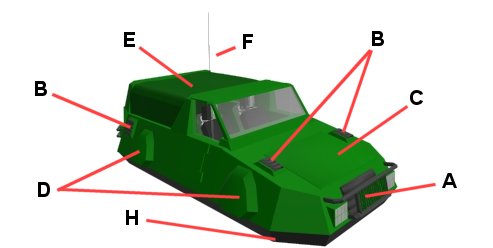
| A - Primary air intake
B - Jump jet air intake C - Engine compartment D - Jump jets E - Cargo compartment F - Radio wave antenna G - Rear door H - Plenum |
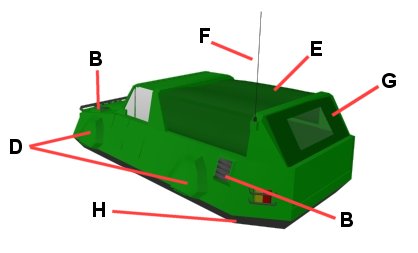
|
The GS and CEW Hover Rovers have no standard weapon fits but the GS can carry a weapon on a pintel mount. This can be either a L95 machine gun, Light Plasma Weapon or an M/RSU firing post with a single Green Hunter missile. Heavier weapons can be mounted if available, GS Hover Rovers belonging to British Army Training Team on Tanstaafl were seen with 12mm DunArmCo heavy machine guns for example. The HR500Q has a similar weapons fit. The WMR and WMR+ have two weapon mounting points. The first is the gyrostabiliser arm mounted by the commander's position. In British service this usually holds a L95 machine gun or an LPW. The second mount is a ring mount above the cargo bay which has a 360 degree traverse. This can hold a single manned weapon like a L95, M/RSU Green Hunter or Darter SAM or the specially designed Lightweight Powered Cupola. The LPC has its own optics and fire control systems with two weapon mounting points and can be controlled by the commander or another passenger. Typical weapon loads include a pair of Green Hunter missiles and a 12mm HMG. Due to the Hover Rover's versatility it can be modified to take virtually any weapon. Those in use on the French Arm have included mortar carriers, heavy plasma gun carriers and autocannon carriers.
Some of these weapons are detailed here. Hover
Rover CEW, 1707 Armoured Tactical Troop, Royal Electronic Warfare and
Security, 79th Armoured Brigade |
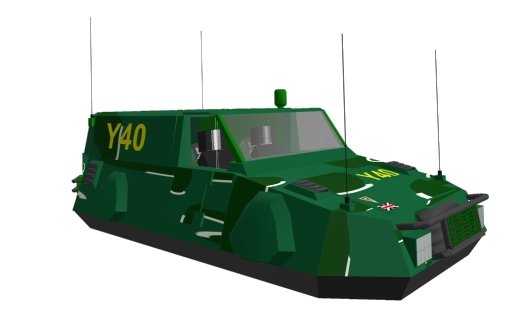
|
The REWS Troop attached to the 79th Armoured Brigade was equipped with a total of 6 Hover Rovers, of which 4 were CEW variants. These were responsible both for gathering Electronic Intelligence and launching EW attacks against the Kafers during the invasion of New Africa in the early months of 2302. This tactical role, conducted against an alien species, was a highly demanding one and 1707 Troop had some success. These vehicles were often found well forward with the fighting echelons to eavesdrop on Kafer tactical communications and at least two were destroyed. Although stuffed with exotic EW and Comms equipment the Hover Rover resembles a fairly typical CEW vehicle. It carries both the union flag and 79 Brigade's Bull Head insignia, whilst carrying the tactical callsign of Y40. The 'Y' Callsign was commonly used by units operating in EW, ELINT and SIGINT roles. Hover
Rover 500MWR+, 11 (Interface) Troop, R (Rifles) Squadron, 24 Special Air
Service Regiment |
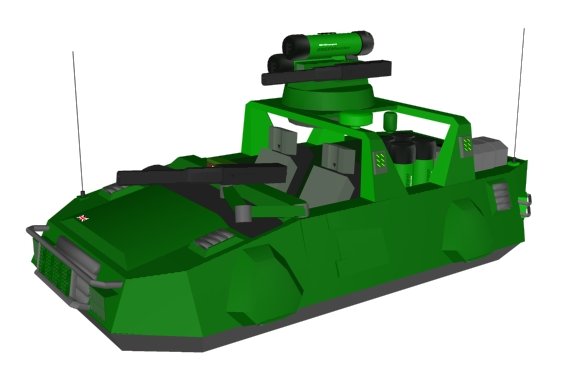
|
The WMR+ shown above was one of a contingent despatched to the British contingent of the Vogelheim peacekeeping force. However these were acquired by a troop of the Special Air Service prior to their deployment to Kafer occupied Dunkelheim in the autumn of 2301. This particular vehicle is equipped with a 12mm HMG in the commander's position and a LPC mounting another 12mm HMG and a pair of Green Hunter AVMs. Distinctive of the WMR+ is the larger engine compartment, extra antenna and countermeasures kits on the roll bars. This vehicle's cargo bay is heavily loaded with Green Hunter reloads, water jerrycans and although not visible in this picture numerous ammunition containers. The WMR+'s used by this unit saw heavy action including several running firefights with Kafer armoured vehicles. They were ultimately abandoned on-world when the unit was redeployed and were subsequently used by the German resistance movement. The only identifying marks were two small union flags on the front and rear of the vehicle. Hover
Rover 500Q, Unknown UKSF unit |
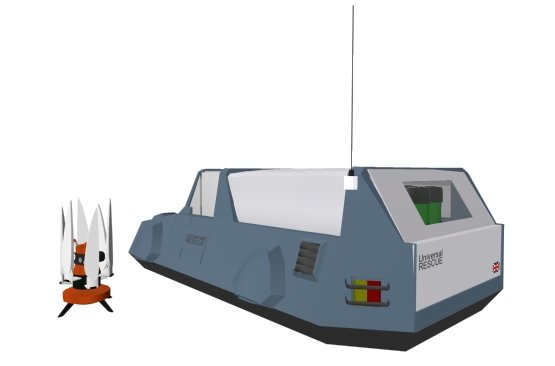
|
A rare photo of a Hover Rover 500Q. Initially thought to be a GS vehicle owned by an aid agency working in war devastated Tanstaafl on Aurore, this HR was spotted by the press close to a major battle being fought by the 2nd Militia Regiment. The presence of an armed crew dressed in civilian clothing was unremarkable, but the clear presence of a large number of Green Hunter missiles and a Snapdragon sensor drone made the real identity of the crew obvious. Whilst the press were quickly hustled away, later investigation revealed Universal Rescue to be a front company run out of empty premises in downtown Tanstaafl City. The exact unit this vehicle belonged to has never been revealed, some say it was 4 SPS, others that it was part of a technical intelligence unit attached to the British Army Training Team Tanstaafl. |